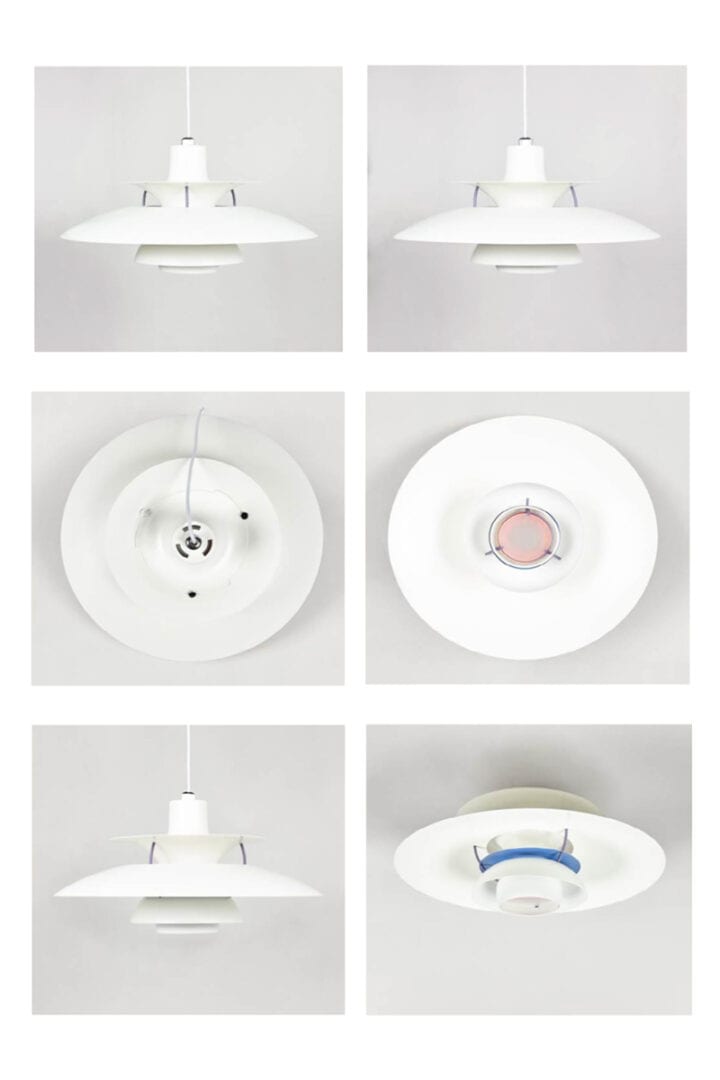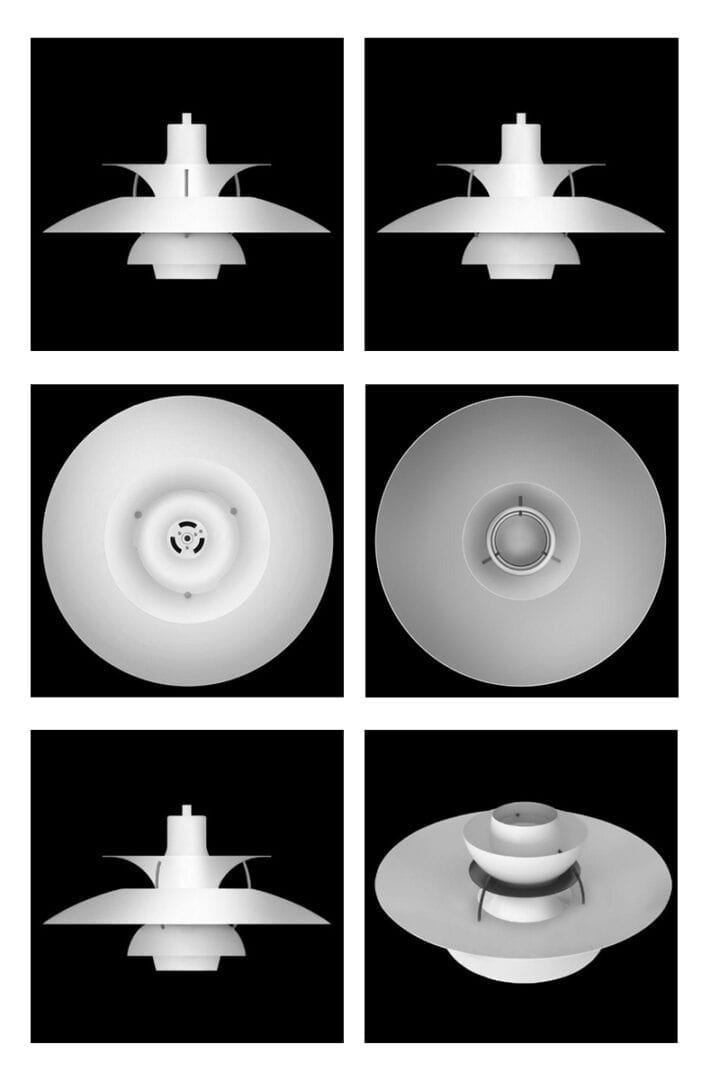The blog article just arrived from Darts-ip user, Japanese Trademark Attorney Mr. Shoji Nakamura from Markstone IP Attorneys!
Tokyo District Court, Judgment dated December 27, 2018, 平成29(ワ)22543 Case seeking injunction against trademark infringement (“Lamp shade” case) (darts-966-637-F-ja)
Summary
In February 2016, a lighting manufacturer, Louis Poulsen, has acquired trademark right on three-dimensional trademark with respect to the shape of their lighting titled “PH5”. This lighting “PH5” was designed by a lighting designer, Paul Henningsen (1894-1967).
The present case was brought before Tokyo District Court by Louis Poulsen, based on the above-identified trademark right, against a company manufacturing and selling replica furniture, to seek an injunction and compensation for damages.
The court has found that the defendant has infringed trademark of the plaintiff, and granted injunction of the replica furniture and compensation for damages.
Case Summary
1. The parties
Plaintiff: Louis Poulsen Lighting A/S (the “Plaintiff”)
Defendant: Kabushiki Kaisha R&M JaPan (the “Defendant”)
2. Plaintiff’s trademark right
| Registration No. | JP 5825191 |
| Filing date: | December 13, 2013 |
| Registration date | February 12, 2016 |
| Trademark
(Plaintiff’s mark) |
[three-dimensional trademark]
|
| Designated goods | Class 11 “Lamp shades” |
3. Defendant’s product
| Defendant’s mark | 
* Cited from “list of Defendant’s mark” in Attachment 3 of the Judgment |
| Defendant’s product | Lighting apparatus |
4. Prosecution history of Plaintiff’s trademark
Plaintiff filed their trademark application (“Plaintiff’s trademark”) on December 13, 2013. During the examination stage, JPO issued a Decision of Refusal based on lack of distinctiveness (Article 3, Section 1, Paragraph 3 of the Trademark Law) in connection with the trademark application.
Plaintiff filed an appeal against examiner’s decision of refusal. The Administrative Judges has found that, although Plaintiff’s trademark merely indicates the shape of the product in a manner used commonly, and does not have inherent distinctiveness, the consumers and distributors have come to realize that the three-dimensional shape that is substantially identical to the three-dimensional trademark according to Plaintiff’s trademark is a product pertaining to the business of the Applicant, since Plaintiff has used such three-dimensional shape in Japan for more than 40 years, and granted registration of Plaintiff’s trademark (不服 2015-764 (darts-273-581-D-ja)).
The goods designated in Plaintiff’s trademark at the time of filing included numerous products, such as “lighting apparatus and accessories thereof; lighting installations; electric lamps”. However, the designated goods has been amended to “lamp shades”, concurrently with the submission of the Written Argument against the Notification of Reasons for Refusal at the examination stage.
5. Major actions by Defendant
Defendant has imported Defendant’s product from China, and sold the same via websites.
6. Major issues
(1) Similarity of trademark (whether or not Plaintiff’s trademark is identical to Defendant’s mark)
(2) Similarity of goods (whether or not the designated goods of Plaintiff’s trademark, i.e. “lamp shades”, are similar to Defendant’s product “lighting apparatus”)
(3) Grounds for invalidation (whether or not there are grounds for invalidation in Plaintiff’s trademark)
7. Outline of court judgment on each issue
| Issue | Plaintiff’s claims | Defendant’s claims | Court judgement |
| Similarity of trademark | – Constituent elements of Defendant’s mark are identical to constituent elements of Plaintiff’s trademark. | – Deny or contest (without giving specific argument). | Conclusion: identical
– Appearances are identical, and there is no difference in concept and sound between the two. – Even if Defendant emphasized that Plaintiff’s products are the genuine product when selling Defendant’s product, or sold Defendant’s product at a price lower than that of Plaintiff’s product, it will not constitute actual state of transaction that would deny the likelihood of deception or confusion as to the origin of goods. |
| Similarity of goods | – Range of users is identical.
– The two fall under the relationship of finished goods and parts thereof. => “Lamp shades” and “lighting apparatus” are similar to each other. |
– Since designated goods of Plaintiff’s trademark has been amended to “lamp shades”, the scope of Plaintiff’s trademark does not cover “lighting apparatus”. | Conclusion: Similar
– Lamp shades and lighting apparatus share retail stores, point of sales, and users. – There is no intended end-usage of lamp shades other than for lighting apparatus. => The two have very strong relationship as a product. |
| Grounds for invalidation | [Distinctiveness (Article 3, Section 1, Paragraph 3 of the Trademark Law)]
– Continued sales of Plaintiff’s product for more than 40 years, with a sales volume of 74,627 products. – Catalogues with Plaintiff’s products posted are being distributed nationwide. – Plaintiff’s product has been awarded a Good Design Award. |
– Plaintiff’s trademark merely indicates one shape that could be adopted as a lamp shades.
– Sales volume of Plaintiff’s product occupies only 0.04% of overall sales volume of lighting apparatus. – Users recognize the product name “PH5” as the distinguishing sign, and Plaintiff’s trademark remains to be a shape of the product. |
Conclusion: It is found that Plaintiff’s trademark has acquired distinctiveness through use (Article 3, Section 2 of the Trademark Law). |
| [Violation of public order and morality (Article 4, Section 1, Paragraph 7 of the Trademark Law)]
– Plaintiff have been giving warnings to infringers of Plaintiff’s trademark to refrain from continuing infringing activities, whenever an infringer is found, and have been continuing their effort in maintaining their brand value. |
– Plaintiff has violated public order and morality, since Plaintiff obtained Plaintiff’s trademark in order to conduct obstruction of business, such as suspension of import of Defendant’s product. | Conclusion: Plaintiff’s trademark does not violate public order and morality.
– There is nothing unreasonable or unjustifiable by Plaintiff in obtaining trademark registration on Plaintiff’s trademark, and seeking suspension of import of Defendant’s product, which is a counterfeit product of Plaintiff’s product. |
|
| [Three-dimensional shape indispensable in securing its function (Article 4, Section 1, Paragraph 18 of the Trademark Law)]
– The structure of lamp shades for achieving the function insisted by Defendant is not limited to Plaintiff’s trademark, and numerous possibilities exist. |
– Plaintiff’s trademark is a three-dimensional shape indispensable in securing the function of maintaining brightness that makes it possible to clearly recognize faces of person in the surroundings, and of eliminating discomfort given by the glare of the light source almost completely. | Conclusion: Plaintiff’s trademark is not a three-dimensional shape indispensable in securing its function.
– Numerous possibilities exists in the shape of the lamp shades, such as the number of shades. – The structure for achieving the function insisted by Defendant is not limited to Plaintiff’s trademark. |
The court has decided on each of the issues as listed above, and has found the actions of Defendant to be trademark infringement activities. The court has ordered Defendant to suspend the manufacture, import, and sales of Defendant’s product, and to pay approximately 4.41 million Japanese yen as damages.
8. Comments
On the basis of the three-dimensional trademark related to a shape of a product, the present judgment has suspended the activities of another company selling products with identical shapes.
The three-dimensional trademark system was introduced to Japan in 1997. In general, the shape itself of a product or a packaging container that does not have inherent distinctiveness may be granted protection, on condition that it has acquired distinctiveness through use (Article 3, Section 2 of the Trademark Law).
Likewise, Plaintiff’s trademark has been refused during the prosecution stage. Registration was granted in the appeal against examiner’s decision of refusal, since it was found during appeal stage that Plaintiff’s trademark has acquired distinctiveness through use.
The Hermes Burkin Bag case was the first-ever infringement case in which the similarity of a three-dimensional trademark that does not contain elements such as characters and figures has been contested (Tokyo District Court, May 21, 2014, 平成25(ワ)31446 (darts-673-677-B-ja)). The present case must be the second in history.
In the Hermes Burkin Bag case, the court has made consideration on the similarity in the appearance of the image that is reflected in the visual perception of the viewer seeing the product from a predetermined direction. However, there was no such consideration made in the present judgment. The court has found that Defendant’s mark is identical to Plaintiff’s trademark, on the basis of the comparison of each element constituting the three-dimensional trademark. This conclusion may have been given based on the fact that the Defendant’s product has almost identical shape with Plaintiff’s product (Plaintiff’s trademark), since Defendant’s product has been sold claiming that it is a replica furniture of Plaintiff’s product.
Now, the shape of the product itself is subject to industrial design registration, if it has novelty. When registered, the owner may enjoy exclusive right on the shape of the product, during duration of the industrial design right.
On the other hand, the fundamental rule is that, when the industrial design right expires, the shape of the product that had been protected thereby becomes a public domain, and may be used freely by anyone.
As such, specifically in the field of furniture, there are numerous products in the market called replica furniture imitating the shapes of famous furniture that are outside the protection provided by industrial design rights.
As a case that sought injunction and compensation of damages for furniture with no protection by industrial design right, there was a case where the plaintiff filed a lawsuit based on copyright infringement of a baby chair (“TRIPP TRAPP” chair shape imitation case, IP high court, judgment dated April 14, 2015,平成26(ネ)10063(darts-578-722-C-ja)). The present case sought protection of product shape based on the Trademark Law, and has opened the gateway for a new approach that could be taken against replica furniture.
In order to obtain trademark right, the three-dimensional trademark related to a product shape must establish acquisition of distinctiveness through use. Further, the other party may claim invalidity for lack of distinctiveness in the infringement lawsuit, or may separately file a trail for invalidation.
In fact, it has been necessary for Plaintiff to establish well-known status of Plaintiff’s trademark during prosecution. Defendant claimed invalidity of Plaintiff’s trademark during trial, and further filed a separate trial for invalidation against Plaintiff’s trademark.
Therefore, we cannot say that trademark right on three-dimensional trademark related to a product shape may be obtained and maintained easily.
However, if the trademark right is successfully obtained, the trademark owner can enjoy semi-permanent exclusivity, by managing such product shape to remain clearly separated from shapes that are used commonly. In addition, a registered trademark has an advantage in that it cannot be contested with grounds for invalidation such as distinctiveness, after five (5) years from registration (Article 47, Section 1 of the Trademark Law).
In the trial for invalidation against Plaintiff’s trademark mentioned above, a decision finding that there are no grounds for invalidation in Plaintiff’s trademark has been given. Defendant has subsequently filed a litigation requesting cancellation of the trial decision, however, the court has found that there are no grounds for invalidation in Plaintiff’s trademark, similarly to the decision given by the court with respect to the claim of invalidity made by Defendant in the present case (Tokyo District Court, judgment dated November 26, 2019, 令和1(行ケ)10086(darts-640-043-H-ja)). In that case, if five (5) years lapse from registration of Plaintiff’s trademark, then Plaintiff should be able to obtain semi-permanent exclusivity on the lamp shades having such shape.
As have been explained above, the present judgment may be regarded as a judgment that revealed the effectiveness of the three-dimensional trademark in the field of furniture as a countermeasure against replica furniture.






